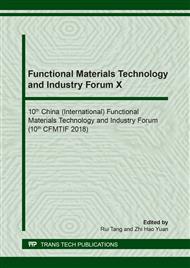[1]
D. T. Burns, R. J. Lewis, J. Bridges, Analytica Chimica Acta, 375 (1998) 255-260.
Google Scholar
[2]
M. H. Keshavarz, Journal of Hazardous Materials A119 (2005) 25–29.
Google Scholar
[3]
B.M. Rice, J. Hare, Thermochimica Acta, 384 (2002) 377–391.
Google Scholar
[4]
D.L. Ye, J.H. Hu, Practical handbook of energetic data for inorganic compounds, 2nd Edition, Metallurgical Industry Press, Beijing, China, 2002, pp.533-594.
Google Scholar
[5]
J. Akhavan, The Chemistry of Explosives. The Royal Society of Chemistry, Cambridge, U.K., 1998, p.103.
Google Scholar
[6]
S.M. Xu, Journal of Shenyang Institute of Technology, 13 (3) (1994) 55-61.
Google Scholar
[7]
X.S. Xu, W.X. Zhang, Theoretical Guide of Banausic State Equation. Science Press, Beijing, China, 1986. p.270.
Google Scholar
[8]
J.A. Zukas, W.P. Walters, Explosive Effects and Applications. Springer-Verlag New York, Inc., New York, U.S.A., 1998, p.124.
Google Scholar
[9]
P.W. Chen, F.L. Huang, S.R. Yun, Materials Research Bulletin 39 (2004) 1589–1597.
Google Scholar
[10]
J.B. Donnet, E. Fousson, T.K. Wang, M. Samirant, C. Baras, M. Pontier Johnson. Diamond and Related Materials 9 (2000) 887–892.
DOI: 10.1016/s0925-9635(99)00215-0
Google Scholar
[11]
S. Zeman, Thermoch[1] D. T. Burns, R. J. Lewis, J. Bridges, Analytica Chimica Acta, 375 (1998) 255-260.
Google Scholar
[12]
X.M. Lin, L.P. Li, G.S. Li, W.H. Su, Materials Chemistry and Physics 69 (2001) 236–240.
Google Scholar
[13]
X.J. Li, X.H. Xie, R.Y. Li, Explosion and Shock Waves 25 (3) (2005) 271-275.
Google Scholar
[14]
X.H. Xie, X.J. Li, R.Y. Li, H.H. Yan, Y.D. Qu & T. Chen, in: Y.J. Wang, P. Huang, S.C. Li (Eds.), Theory and Practice of Energetic Materials Vol.Ⅵ. Science Press, Beijing, China, 2005, pp.169-174.
Google Scholar
[15]
X.J. Li, X.H. Xie, R.Y. Li, Y.D. Qu & T. Chen, in: Y.J. Wang, P. Huang, S.C. Li (Eds.), Theory and Practice of Energetic Materials Vol.Ⅵ. Science Press, Beijing, China, 2005, pp.153-158. imica Acta, 384 (2002) 137–154.
Google Scholar
[16]
S. Komaba, S.T. Myung, N. Kumagai, T. Kanouchi, K. Oikawa, T. Kamiyama: Solid State Ionics, Vol. 152–153 (2002), p.311.
Google Scholar
[17]
P.W. Chen, Y.S. Ding, Q. Chen, and F.L. Huang, S.R. Yun: Diamond and Related Materials, Vol. 9 (2000), p.1722.
Google Scholar
[18]
S. I. Troyanov, A. N. Tsvigunov, V. G. Khotin, and T. B. Puzyreva: Glass and Ceramics, Vol. 57 (2000), p.241.
DOI: 10.1023/a:1007146213813
Google Scholar
[19]
X.H. Xie, X.J. Li, R.Y. Li, H.H. Yan, Y.D. Qu and T. Chen, in: Theory and Practice of Energetic Materials Vol.Ⅵ, edited by Y.J. Wang, P. Huang and S.C. Li, p.169, China Science Press (2005).
Google Scholar
[20]
X.J. Li, X.H. Xie, R.Y. Li, H.H. Yan, Y.D. Qu and T. Chen, in: Theory and Practice of Energetic Materials Vol.Ⅵ, edited by Y.J. Wang, P. Huang and S.C. Li, p.153, China Science Press (2005).
Google Scholar
[21]
X.J. Li, X.H. Xie, and R.Y. Li: Explosion and Shock Waves. Vol. 25 (2005), p.271.
Google Scholar
[22]
Xinghua, Xie, Xiaokang Zhang.Electricity-heat response of firing materials. Integrated Ferroelectrics188 (2018) 103-111.
Google Scholar
[23]
Xinghua, Xie, Xiaokang Zhang.Millisecond detonator with high delay precision. Integrated Ferroelectrics 188(2018) 88- 91.
DOI: 10.1080/10584587.2018.1454210
Google Scholar
[24]
Huisheng Zhou, Xinghua Xie & Xiaokang Zhang. Investigation onto nanometer millisecond delay charges, Integrated Ferroelectrics 188 (2018) 92-95.
DOI: 10.1080/10584587.2018.1454212
Google Scholar
[25]
Huisheng Zhou, Xinghua Xie and Yuqing Feng. Rock breaking methods to replace blasting. Materials Science and Engineering 322(2018) 83-88.
Google Scholar
[26]
Xinghua Xie, Yuqing Feng and Huisheng Zhou. Novel special energy for environmental friendly excavation. Materials Science and Engineering 322(2018) 1-5.
Google Scholar
[27]
Xie Xinghua, Zhou Huisheng, Zheng Deming, Li Xiaojie. Nano powders from explosives. Ordnance Industry Press, Beijing, (2018).
Google Scholar
[28]
Xie Xinghua, Zhang Xiaokang, et al. A rock breaking grain and its preparation method. P.R. China patent 201610911364.4. (2018).
Google Scholar
[29]
Xie Xinghua, Zhang Xiaokang et al. Charge structure and charging method of rock-breaking charge pillar. P.R. China patent 201610911366.3. (2018).
Google Scholar
[30]
Xie Xinghua, Zhang Xiaokang, et al. [P]. A thermobaric detonating cord and its manufacturing method. P.R. China patent 201610971373.2. (2018).
Google Scholar


